Leadership and Change Management: NHS Case Study Report Evaluation
VerifiedAdded on 2022/12/16
|16
|5334
|484
Report
AI Summary
This report analyzes a case study of the National Health Service (NHS) and its organizational changes. The report examines the triggers for change, including strategic focus and market changes, and explores Grundy's theory of change, specifically focusing on smooth incremental change. It also delves into the types of changes experienced by the NHS, such as restructuring to address confusion among employees and improve service delivery. The report further investigates the impact of change on the organization's social and cultural aspects, analyzing Handy's culture model and the shifts in power dynamics, task orientation, and roles. Finally, the report provides recommendations for leaders to manage organizational change, addressing leadership issues, employee engagement, and organizational development to ensure the NHS adapts effectively to its changing environment and sustains its operations.
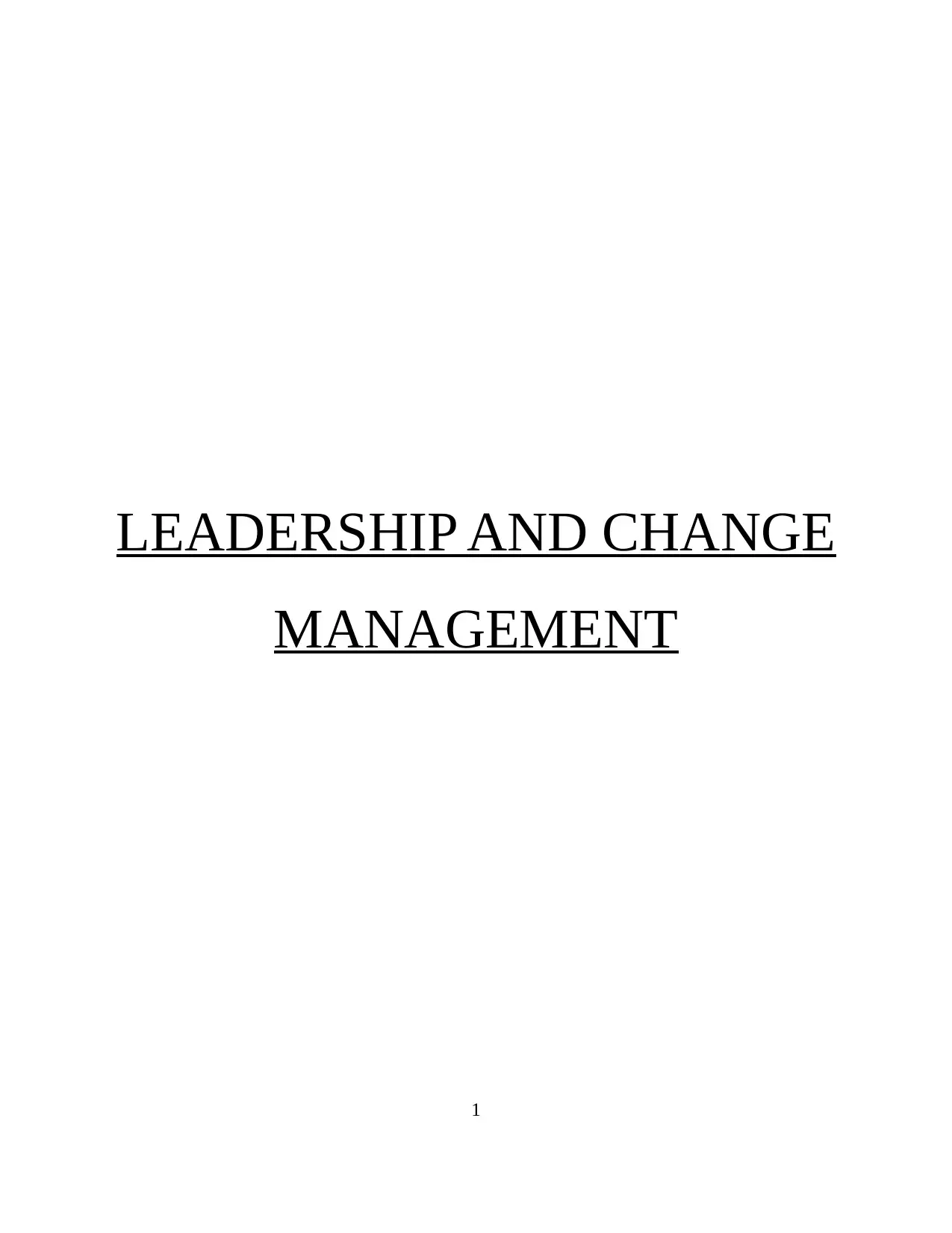
LEADERSHIP AND CHANGE
MANAGEMENT
1
MANAGEMENT
1
Paraphrase This Document
Need a fresh take? Get an instant paraphrase of this document with our AI Paraphraser
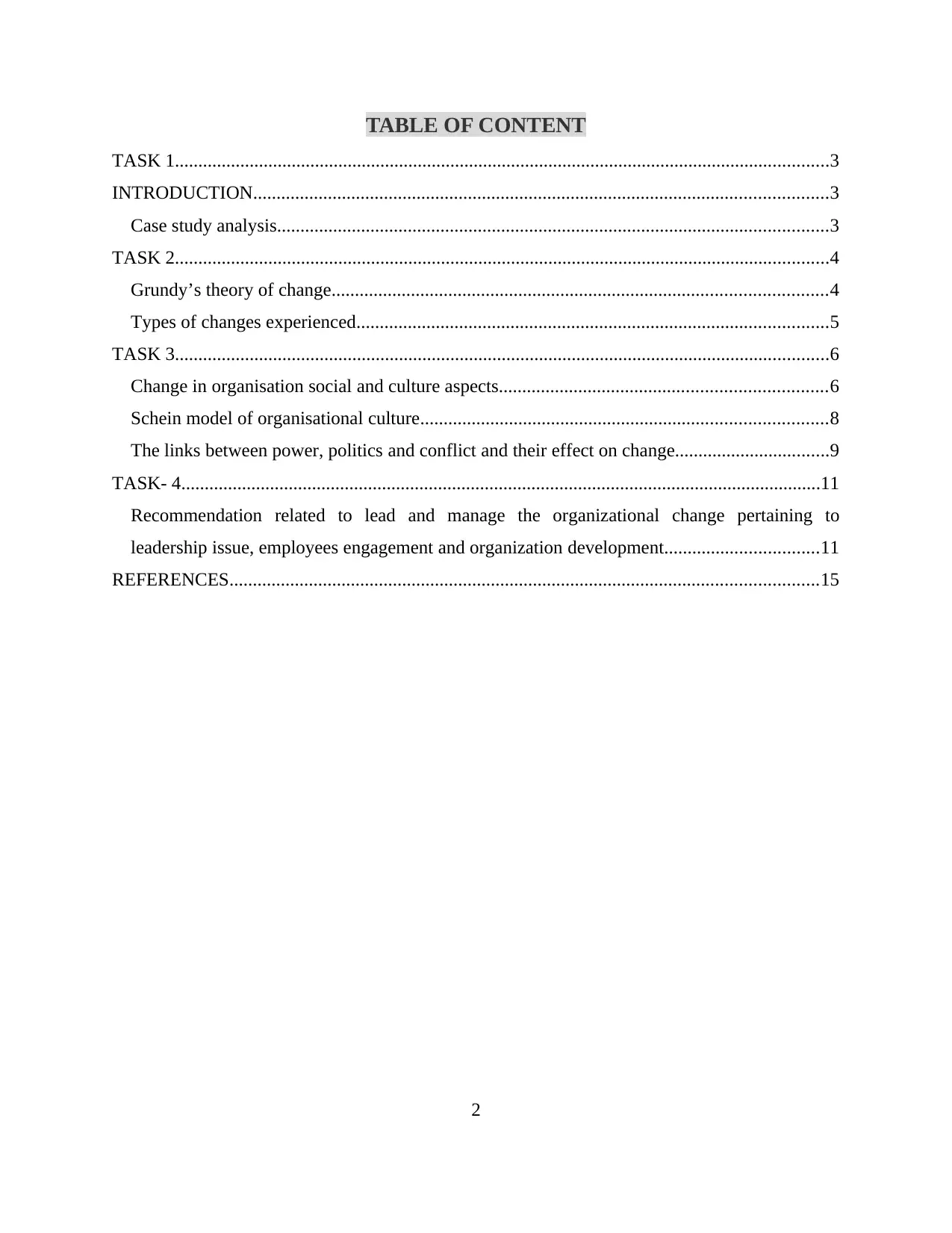
TABLE OF CONTENT
TASK 1............................................................................................................................................3
INTRODUCTION...........................................................................................................................3
Case study analysis......................................................................................................................3
TASK 2............................................................................................................................................4
Grundy’s theory of change..........................................................................................................4
Types of changes experienced.....................................................................................................5
TASK 3............................................................................................................................................6
Change in organisation social and culture aspects......................................................................6
Schein model of organisational culture.......................................................................................8
The links between power, politics and conflict and their effect on change.................................9
TASK- 4.........................................................................................................................................11
Recommendation related to lead and manage the organizational change pertaining to
leadership issue, employees engagement and organization development.................................11
REFERENCES..............................................................................................................................15
2
TASK 1............................................................................................................................................3
INTRODUCTION...........................................................................................................................3
Case study analysis......................................................................................................................3
TASK 2............................................................................................................................................4
Grundy’s theory of change..........................................................................................................4
Types of changes experienced.....................................................................................................5
TASK 3............................................................................................................................................6
Change in organisation social and culture aspects......................................................................6
Schein model of organisational culture.......................................................................................8
The links between power, politics and conflict and their effect on change.................................9
TASK- 4.........................................................................................................................................11
Recommendation related to lead and manage the organizational change pertaining to
leadership issue, employees engagement and organization development.................................11
REFERENCES..............................................................................................................................15
2
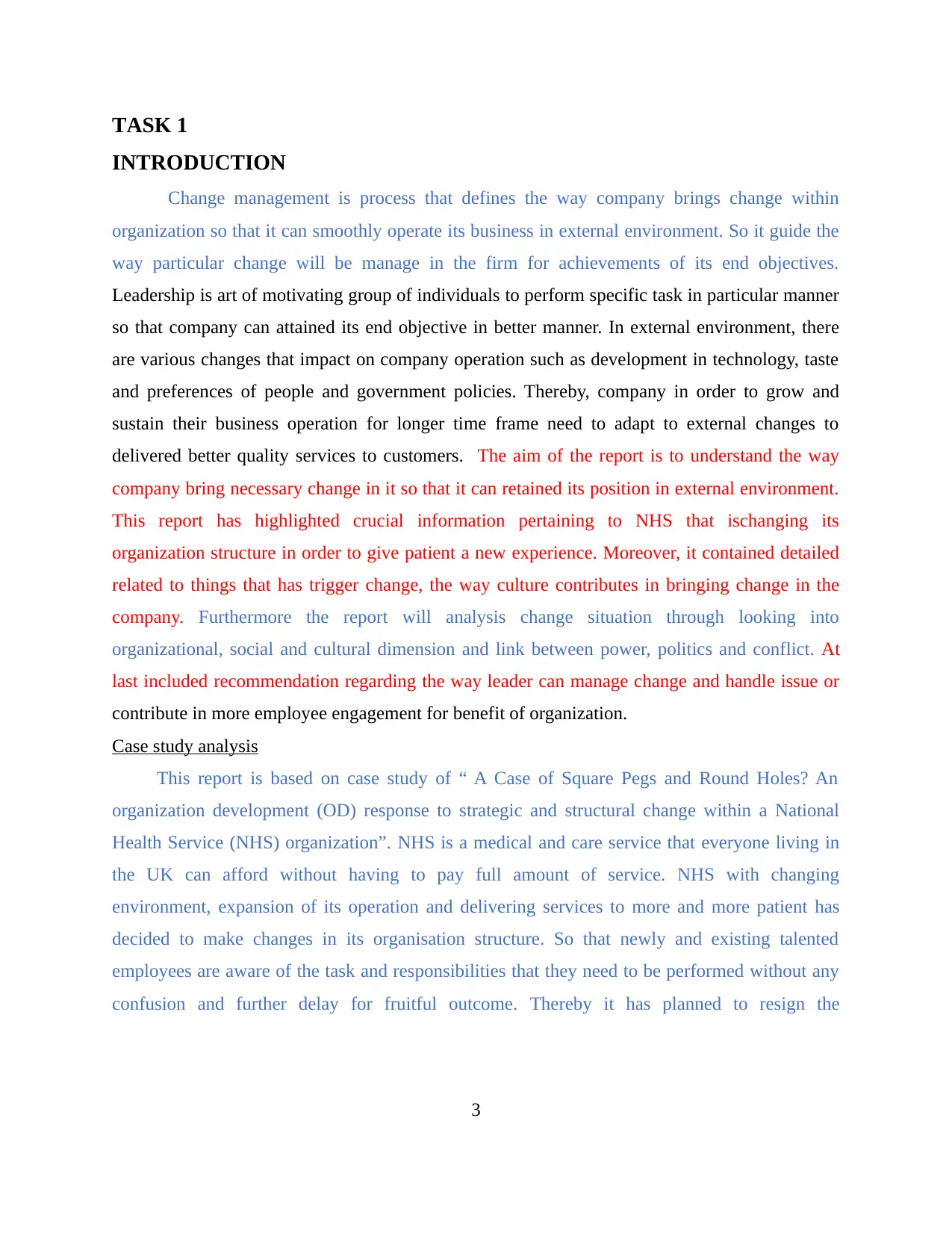
TASK 1
INTRODUCTION
Change management is process that defines the way company brings change within
organization so that it can smoothly operate its business in external environment. So it guide the
way particular change will be manage in the firm for achievements of its end objectives.
Leadership is art of motivating group of individuals to perform specific task in particular manner
so that company can attained its end objective in better manner. In external environment, there
are various changes that impact on company operation such as development in technology, taste
and preferences of people and government policies. Thereby, company in order to grow and
sustain their business operation for longer time frame need to adapt to external changes to
delivered better quality services to customers. The aim of the report is to understand the way
company bring necessary change in it so that it can retained its position in external environment.
This report has highlighted crucial information pertaining to NHS that ischanging its
organization structure in order to give patient a new experience. Moreover, it contained detailed
related to things that has trigger change, the way culture contributes in bringing change in the
company. Furthermore the report will analysis change situation through looking into
organizational, social and cultural dimension and link between power, politics and conflict. At
last included recommendation regarding the way leader can manage change and handle issue or
contribute in more employee engagement for benefit of organization.
Case study analysis
This report is based on case study of “ A Case of Square Pegs and Round Holes? An
organization development (OD) response to strategic and structural change within a National
Health Service (NHS) organization”. NHS is a medical and care service that everyone living in
the UK can afford without having to pay full amount of service. NHS with changing
environment, expansion of its operation and delivering services to more and more patient has
decided to make changes in its organisation structure. So that newly and existing talented
employees are aware of the task and responsibilities that they need to be performed without any
confusion and further delay for fruitful outcome. Thereby it has planned to resign the
3
INTRODUCTION
Change management is process that defines the way company brings change within
organization so that it can smoothly operate its business in external environment. So it guide the
way particular change will be manage in the firm for achievements of its end objectives.
Leadership is art of motivating group of individuals to perform specific task in particular manner
so that company can attained its end objective in better manner. In external environment, there
are various changes that impact on company operation such as development in technology, taste
and preferences of people and government policies. Thereby, company in order to grow and
sustain their business operation for longer time frame need to adapt to external changes to
delivered better quality services to customers. The aim of the report is to understand the way
company bring necessary change in it so that it can retained its position in external environment.
This report has highlighted crucial information pertaining to NHS that ischanging its
organization structure in order to give patient a new experience. Moreover, it contained detailed
related to things that has trigger change, the way culture contributes in bringing change in the
company. Furthermore the report will analysis change situation through looking into
organizational, social and cultural dimension and link between power, politics and conflict. At
last included recommendation regarding the way leader can manage change and handle issue or
contribute in more employee engagement for benefit of organization.
Case study analysis
This report is based on case study of “ A Case of Square Pegs and Round Holes? An
organization development (OD) response to strategic and structural change within a National
Health Service (NHS) organization”. NHS is a medical and care service that everyone living in
the UK can afford without having to pay full amount of service. NHS with changing
environment, expansion of its operation and delivering services to more and more patient has
decided to make changes in its organisation structure. So that newly and existing talented
employees are aware of the task and responsibilities that they need to be performed without any
confusion and further delay for fruitful outcome. Thereby it has planned to resign the
3
⊘ This is a preview!⊘
Do you want full access?
Subscribe today to unlock all pages.

Trusted by 1+ million students worldwide
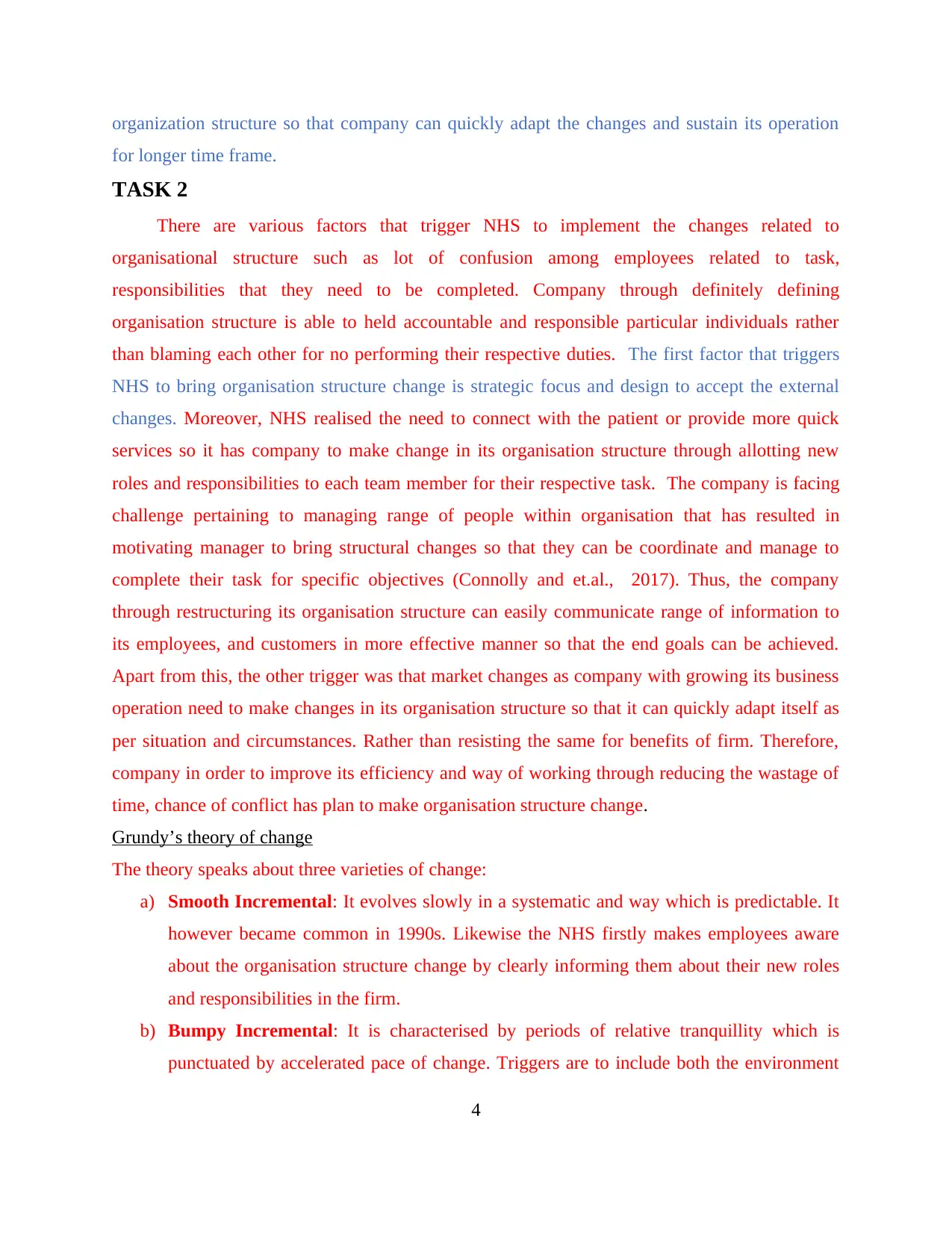
organization structure so that company can quickly adapt the changes and sustain its operation
for longer time frame.
TASK 2
There are various factors that trigger NHS to implement the changes related to
organisational structure such as lot of confusion among employees related to task,
responsibilities that they need to be completed. Company through definitely defining
organisation structure is able to held accountable and responsible particular individuals rather
than blaming each other for no performing their respective duties. The first factor that triggers
NHS to bring organisation structure change is strategic focus and design to accept the external
changes. Moreover, NHS realised the need to connect with the patient or provide more quick
services so it has company to make change in its organisation structure through allotting new
roles and responsibilities to each team member for their respective task. The company is facing
challenge pertaining to managing range of people within organisation that has resulted in
motivating manager to bring structural changes so that they can be coordinate and manage to
complete their task for specific objectives (Connolly and et.al., 2017). Thus, the company
through restructuring its organisation structure can easily communicate range of information to
its employees, and customers in more effective manner so that the end goals can be achieved.
Apart from this, the other trigger was that market changes as company with growing its business
operation need to make changes in its organisation structure so that it can quickly adapt itself as
per situation and circumstances. Rather than resisting the same for benefits of firm. Therefore,
company in order to improve its efficiency and way of working through reducing the wastage of
time, chance of conflict has plan to make organisation structure change.
Grundy’s theory of change
The theory speaks about three varieties of change:
a) Smooth Incremental: It evolves slowly in a systematic and way which is predictable. It
however became common in 1990s. Likewise the NHS firstly makes employees aware
about the organisation structure change by clearly informing them about their new roles
and responsibilities in the firm.
b) Bumpy Incremental: It is characterised by periods of relative tranquillity which is
punctuated by accelerated pace of change. Triggers are to include both the environment
4
for longer time frame.
TASK 2
There are various factors that trigger NHS to implement the changes related to
organisational structure such as lot of confusion among employees related to task,
responsibilities that they need to be completed. Company through definitely defining
organisation structure is able to held accountable and responsible particular individuals rather
than blaming each other for no performing their respective duties. The first factor that triggers
NHS to bring organisation structure change is strategic focus and design to accept the external
changes. Moreover, NHS realised the need to connect with the patient or provide more quick
services so it has company to make change in its organisation structure through allotting new
roles and responsibilities to each team member for their respective task. The company is facing
challenge pertaining to managing range of people within organisation that has resulted in
motivating manager to bring structural changes so that they can be coordinate and manage to
complete their task for specific objectives (Connolly and et.al., 2017). Thus, the company
through restructuring its organisation structure can easily communicate range of information to
its employees, and customers in more effective manner so that the end goals can be achieved.
Apart from this, the other trigger was that market changes as company with growing its business
operation need to make changes in its organisation structure so that it can quickly adapt itself as
per situation and circumstances. Rather than resisting the same for benefits of firm. Therefore,
company in order to improve its efficiency and way of working through reducing the wastage of
time, chance of conflict has plan to make organisation structure change.
Grundy’s theory of change
The theory speaks about three varieties of change:
a) Smooth Incremental: It evolves slowly in a systematic and way which is predictable. It
however became common in 1990s. Likewise the NHS firstly makes employees aware
about the organisation structure change by clearly informing them about their new roles
and responsibilities in the firm.
b) Bumpy Incremental: It is characterised by periods of relative tranquillity which is
punctuated by accelerated pace of change. Triggers are to include both the environment
4
Paraphrase This Document
Need a fresh take? Get an instant paraphrase of this document with our AI Paraphraser
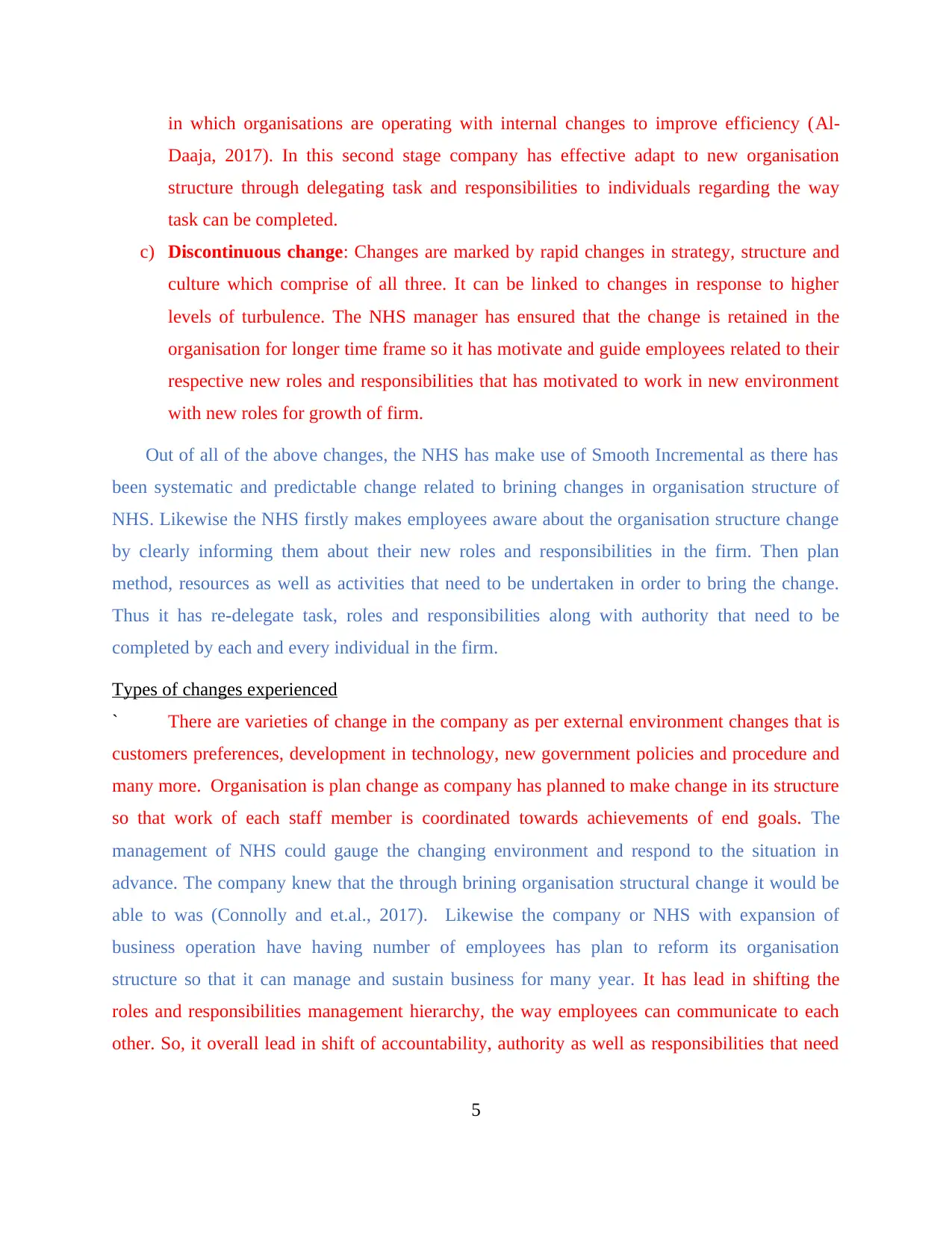
in which organisations are operating with internal changes to improve efficiency (Al-
Daaja, 2017). In this second stage company has effective adapt to new organisation
structure through delegating task and responsibilities to individuals regarding the way
task can be completed.
c) Discontinuous change: Changes are marked by rapid changes in strategy, structure and
culture which comprise of all three. It can be linked to changes in response to higher
levels of turbulence. The NHS manager has ensured that the change is retained in the
organisation for longer time frame so it has motivate and guide employees related to their
respective new roles and responsibilities that has motivated to work in new environment
with new roles for growth of firm.
Out of all of the above changes, the NHS has make use of Smooth Incremental as there has
been systematic and predictable change related to brining changes in organisation structure of
NHS. Likewise the NHS firstly makes employees aware about the organisation structure change
by clearly informing them about their new roles and responsibilities in the firm. Then plan
method, resources as well as activities that need to be undertaken in order to bring the change.
Thus it has re-delegate task, roles and responsibilities along with authority that need to be
completed by each and every individual in the firm.
Types of changes experienced
` There are varieties of change in the company as per external environment changes that is
customers preferences, development in technology, new government policies and procedure and
many more. Organisation is plan change as company has planned to make change in its structure
so that work of each staff member is coordinated towards achievements of end goals. The
management of NHS could gauge the changing environment and respond to the situation in
advance. The company knew that the through brining organisation structural change it would be
able to was (Connolly and et.al., 2017). Likewise the company or NHS with expansion of
business operation have having number of employees has plan to reform its organisation
structure so that it can manage and sustain business for many year. It has lead in shifting the
roles and responsibilities management hierarchy, the way employees can communicate to each
other. So, it overall lead in shift of accountability, authority as well as responsibilities that need
5
Daaja, 2017). In this second stage company has effective adapt to new organisation
structure through delegating task and responsibilities to individuals regarding the way
task can be completed.
c) Discontinuous change: Changes are marked by rapid changes in strategy, structure and
culture which comprise of all three. It can be linked to changes in response to higher
levels of turbulence. The NHS manager has ensured that the change is retained in the
organisation for longer time frame so it has motivate and guide employees related to their
respective new roles and responsibilities that has motivated to work in new environment
with new roles for growth of firm.
Out of all of the above changes, the NHS has make use of Smooth Incremental as there has
been systematic and predictable change related to brining changes in organisation structure of
NHS. Likewise the NHS firstly makes employees aware about the organisation structure change
by clearly informing them about their new roles and responsibilities in the firm. Then plan
method, resources as well as activities that need to be undertaken in order to bring the change.
Thus it has re-delegate task, roles and responsibilities along with authority that need to be
completed by each and every individual in the firm.
Types of changes experienced
` There are varieties of change in the company as per external environment changes that is
customers preferences, development in technology, new government policies and procedure and
many more. Organisation is plan change as company has planned to make change in its structure
so that work of each staff member is coordinated towards achievements of end goals. The
management of NHS could gauge the changing environment and respond to the situation in
advance. The company knew that the through brining organisation structural change it would be
able to was (Connolly and et.al., 2017). Likewise the company or NHS with expansion of
business operation have having number of employees has plan to reform its organisation
structure so that it can manage and sustain business for many year. It has lead in shifting the
roles and responsibilities management hierarchy, the way employees can communicate to each
other. So, it overall lead in shift of accountability, authority as well as responsibilities that need
5
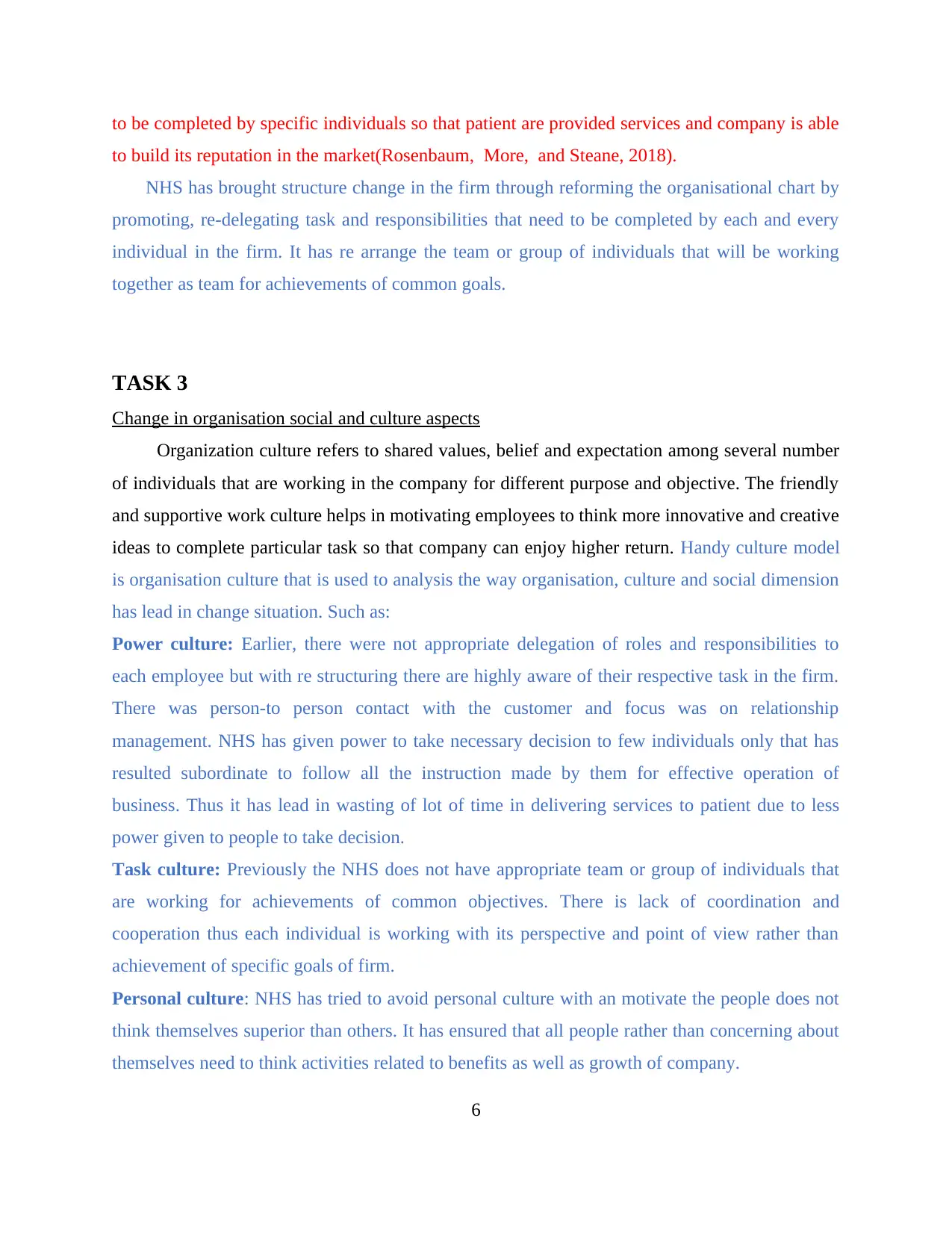
to be completed by specific individuals so that patient are provided services and company is able
to build its reputation in the market(Rosenbaum, More, and Steane, 2018).
NHS has brought structure change in the firm through reforming the organisational chart by
promoting, re-delegating task and responsibilities that need to be completed by each and every
individual in the firm. It has re arrange the team or group of individuals that will be working
together as team for achievements of common goals.
TASK 3
Change in organisation social and culture aspects
Organization culture refers to shared values, belief and expectation among several number
of individuals that are working in the company for different purpose and objective. The friendly
and supportive work culture helps in motivating employees to think more innovative and creative
ideas to complete particular task so that company can enjoy higher return. Handy culture model
is organisation culture that is used to analysis the way organisation, culture and social dimension
has lead in change situation. Such as:
Power culture: Earlier, there were not appropriate delegation of roles and responsibilities to
each employee but with re structuring there are highly aware of their respective task in the firm.
There was person-to person contact with the customer and focus was on relationship
management. NHS has given power to take necessary decision to few individuals only that has
resulted subordinate to follow all the instruction made by them for effective operation of
business. Thus it has lead in wasting of lot of time in delivering services to patient due to less
power given to people to take decision.
Task culture: Previously the NHS does not have appropriate team or group of individuals that
are working for achievements of common objectives. There is lack of coordination and
cooperation thus each individual is working with its perspective and point of view rather than
achievement of specific goals of firm.
Personal culture: NHS has tried to avoid personal culture with an motivate the people does not
think themselves superior than others. It has ensured that all people rather than concerning about
themselves need to think activities related to benefits as well as growth of company.
6
to build its reputation in the market(Rosenbaum, More, and Steane, 2018).
NHS has brought structure change in the firm through reforming the organisational chart by
promoting, re-delegating task and responsibilities that need to be completed by each and every
individual in the firm. It has re arrange the team or group of individuals that will be working
together as team for achievements of common goals.
TASK 3
Change in organisation social and culture aspects
Organization culture refers to shared values, belief and expectation among several number
of individuals that are working in the company for different purpose and objective. The friendly
and supportive work culture helps in motivating employees to think more innovative and creative
ideas to complete particular task so that company can enjoy higher return. Handy culture model
is organisation culture that is used to analysis the way organisation, culture and social dimension
has lead in change situation. Such as:
Power culture: Earlier, there were not appropriate delegation of roles and responsibilities to
each employee but with re structuring there are highly aware of their respective task in the firm.
There was person-to person contact with the customer and focus was on relationship
management. NHS has given power to take necessary decision to few individuals only that has
resulted subordinate to follow all the instruction made by them for effective operation of
business. Thus it has lead in wasting of lot of time in delivering services to patient due to less
power given to people to take decision.
Task culture: Previously the NHS does not have appropriate team or group of individuals that
are working for achievements of common objectives. There is lack of coordination and
cooperation thus each individual is working with its perspective and point of view rather than
achievement of specific goals of firm.
Personal culture: NHS has tried to avoid personal culture with an motivate the people does not
think themselves superior than others. It has ensured that all people rather than concerning about
themselves need to think activities related to benefits as well as growth of company.
6
⊘ This is a preview!⊘
Do you want full access?
Subscribe today to unlock all pages.

Trusted by 1+ million students worldwide
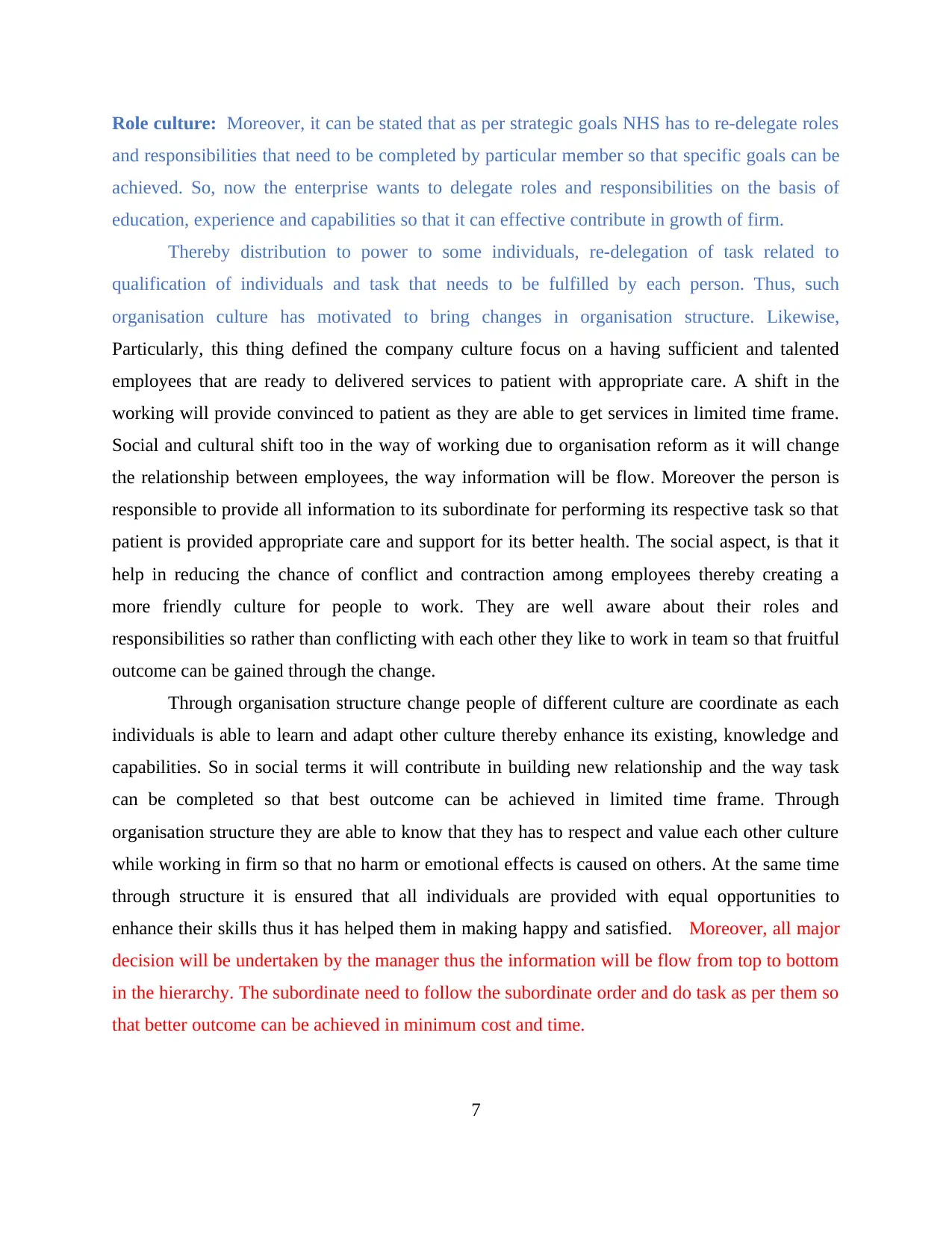
Role culture: Moreover, it can be stated that as per strategic goals NHS has to re-delegate roles
and responsibilities that need to be completed by particular member so that specific goals can be
achieved. So, now the enterprise wants to delegate roles and responsibilities on the basis of
education, experience and capabilities so that it can effective contribute in growth of firm.
Thereby distribution to power to some individuals, re-delegation of task related to
qualification of individuals and task that needs to be fulfilled by each person. Thus, such
organisation culture has motivated to bring changes in organisation structure. Likewise,
Particularly, this thing defined the company culture focus on a having sufficient and talented
employees that are ready to delivered services to patient with appropriate care. A shift in the
working will provide convinced to patient as they are able to get services in limited time frame.
Social and cultural shift too in the way of working due to organisation reform as it will change
the relationship between employees, the way information will be flow. Moreover the person is
responsible to provide all information to its subordinate for performing its respective task so that
patient is provided appropriate care and support for its better health. The social aspect, is that it
help in reducing the chance of conflict and contraction among employees thereby creating a
more friendly culture for people to work. They are well aware about their roles and
responsibilities so rather than conflicting with each other they like to work in team so that fruitful
outcome can be gained through the change.
Through organisation structure change people of different culture are coordinate as each
individuals is able to learn and adapt other culture thereby enhance its existing, knowledge and
capabilities. So in social terms it will contribute in building new relationship and the way task
can be completed so that best outcome can be achieved in limited time frame. Through
organisation structure they are able to know that they has to respect and value each other culture
while working in firm so that no harm or emotional effects is caused on others. At the same time
through structure it is ensured that all individuals are provided with equal opportunities to
enhance their skills thus it has helped them in making happy and satisfied. Moreover, all major
decision will be undertaken by the manager thus the information will be flow from top to bottom
in the hierarchy. The subordinate need to follow the subordinate order and do task as per them so
that better outcome can be achieved in minimum cost and time.
7
and responsibilities that need to be completed by particular member so that specific goals can be
achieved. So, now the enterprise wants to delegate roles and responsibilities on the basis of
education, experience and capabilities so that it can effective contribute in growth of firm.
Thereby distribution to power to some individuals, re-delegation of task related to
qualification of individuals and task that needs to be fulfilled by each person. Thus, such
organisation culture has motivated to bring changes in organisation structure. Likewise,
Particularly, this thing defined the company culture focus on a having sufficient and talented
employees that are ready to delivered services to patient with appropriate care. A shift in the
working will provide convinced to patient as they are able to get services in limited time frame.
Social and cultural shift too in the way of working due to organisation reform as it will change
the relationship between employees, the way information will be flow. Moreover the person is
responsible to provide all information to its subordinate for performing its respective task so that
patient is provided appropriate care and support for its better health. The social aspect, is that it
help in reducing the chance of conflict and contraction among employees thereby creating a
more friendly culture for people to work. They are well aware about their roles and
responsibilities so rather than conflicting with each other they like to work in team so that fruitful
outcome can be gained through the change.
Through organisation structure change people of different culture are coordinate as each
individuals is able to learn and adapt other culture thereby enhance its existing, knowledge and
capabilities. So in social terms it will contribute in building new relationship and the way task
can be completed so that best outcome can be achieved in limited time frame. Through
organisation structure they are able to know that they has to respect and value each other culture
while working in firm so that no harm or emotional effects is caused on others. At the same time
through structure it is ensured that all individuals are provided with equal opportunities to
enhance their skills thus it has helped them in making happy and satisfied. Moreover, all major
decision will be undertaken by the manager thus the information will be flow from top to bottom
in the hierarchy. The subordinate need to follow the subordinate order and do task as per them so
that better outcome can be achieved in minimum cost and time.
7
Paraphrase This Document
Need a fresh take? Get an instant paraphrase of this document with our AI Paraphraser
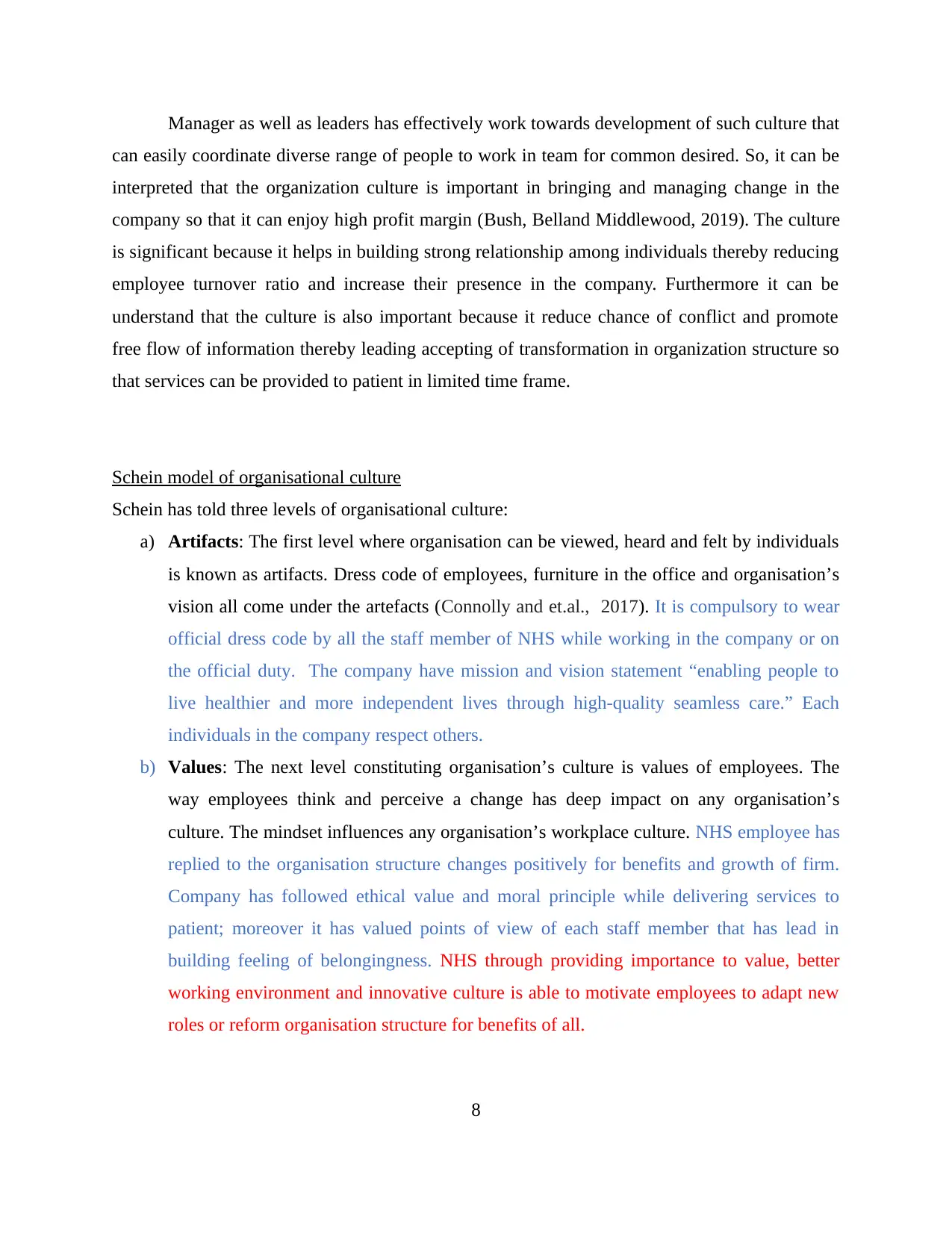
Manager as well as leaders has effectively work towards development of such culture that
can easily coordinate diverse range of people to work in team for common desired. So, it can be
interpreted that the organization culture is important in bringing and managing change in the
company so that it can enjoy high profit margin (Bush, Belland Middlewood, 2019). The culture
is significant because it helps in building strong relationship among individuals thereby reducing
employee turnover ratio and increase their presence in the company. Furthermore it can be
understand that the culture is also important because it reduce chance of conflict and promote
free flow of information thereby leading accepting of transformation in organization structure so
that services can be provided to patient in limited time frame.
Schein model of organisational culture
Schein has told three levels of organisational culture:
a) Artifacts: The first level where organisation can be viewed, heard and felt by individuals
is known as artifacts. Dress code of employees, furniture in the office and organisation’s
vision all come under the artefacts (Connolly and et.al., 2017). It is compulsory to wear
official dress code by all the staff member of NHS while working in the company or on
the official duty. The company have mission and vision statement “enabling people to
live healthier and more independent lives through high-quality seamless care.” Each
individuals in the company respect others.
b) Values: The next level constituting organisation’s culture is values of employees. The
way employees think and perceive a change has deep impact on any organisation’s
culture. The mindset influences any organisation’s workplace culture. NHS employee has
replied to the organisation structure changes positively for benefits and growth of firm.
Company has followed ethical value and moral principle while delivering services to
patient; moreover it has valued points of view of each staff member that has lead in
building feeling of belongingness. NHS through providing importance to value, better
working environment and innovative culture is able to motivate employees to adapt new
roles or reform organisation structure for benefits of all.
8
can easily coordinate diverse range of people to work in team for common desired. So, it can be
interpreted that the organization culture is important in bringing and managing change in the
company so that it can enjoy high profit margin (Bush, Belland Middlewood, 2019). The culture
is significant because it helps in building strong relationship among individuals thereby reducing
employee turnover ratio and increase their presence in the company. Furthermore it can be
understand that the culture is also important because it reduce chance of conflict and promote
free flow of information thereby leading accepting of transformation in organization structure so
that services can be provided to patient in limited time frame.
Schein model of organisational culture
Schein has told three levels of organisational culture:
a) Artifacts: The first level where organisation can be viewed, heard and felt by individuals
is known as artifacts. Dress code of employees, furniture in the office and organisation’s
vision all come under the artefacts (Connolly and et.al., 2017). It is compulsory to wear
official dress code by all the staff member of NHS while working in the company or on
the official duty. The company have mission and vision statement “enabling people to
live healthier and more independent lives through high-quality seamless care.” Each
individuals in the company respect others.
b) Values: The next level constituting organisation’s culture is values of employees. The
way employees think and perceive a change has deep impact on any organisation’s
culture. The mindset influences any organisation’s workplace culture. NHS employee has
replied to the organisation structure changes positively for benefits and growth of firm.
Company has followed ethical value and moral principle while delivering services to
patient; moreover it has valued points of view of each staff member that has lead in
building feeling of belongingness. NHS through providing importance to value, better
working environment and innovative culture is able to motivate employees to adapt new
roles or reform organisation structure for benefits of all.
8
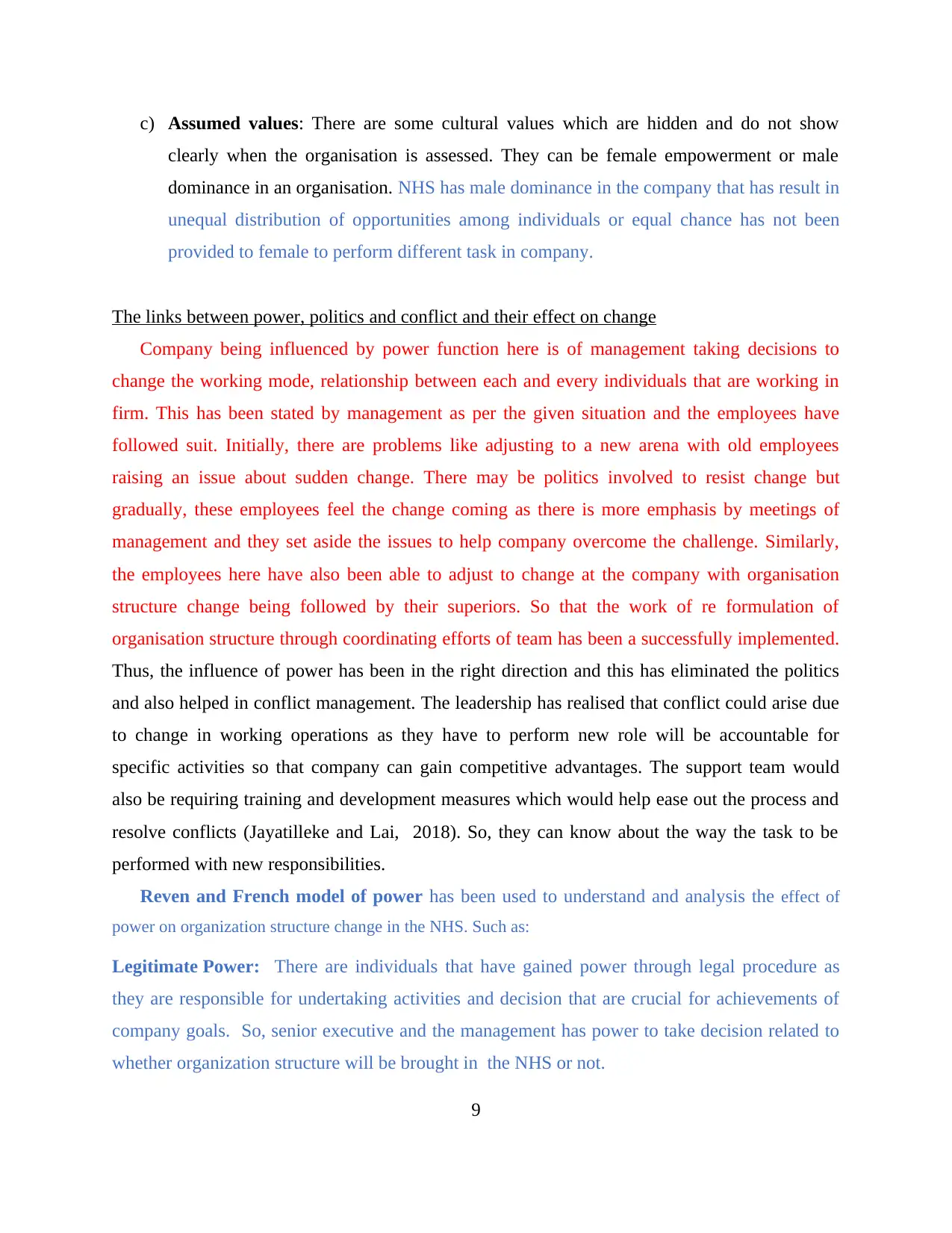
c) Assumed values: There are some cultural values which are hidden and do not show
clearly when the organisation is assessed. They can be female empowerment or male
dominance in an organisation. NHS has male dominance in the company that has result in
unequal distribution of opportunities among individuals or equal chance has not been
provided to female to perform different task in company.
The links between power, politics and conflict and their effect on change
Company being influenced by power function here is of management taking decisions to
change the working mode, relationship between each and every individuals that are working in
firm. This has been stated by management as per the given situation and the employees have
followed suit. Initially, there are problems like adjusting to a new arena with old employees
raising an issue about sudden change. There may be politics involved to resist change but
gradually, these employees feel the change coming as there is more emphasis by meetings of
management and they set aside the issues to help company overcome the challenge. Similarly,
the employees here have also been able to adjust to change at the company with organisation
structure change being followed by their superiors. So that the work of re formulation of
organisation structure through coordinating efforts of team has been a successfully implemented.
Thus, the influence of power has been in the right direction and this has eliminated the politics
and also helped in conflict management. The leadership has realised that conflict could arise due
to change in working operations as they have to perform new role will be accountable for
specific activities so that company can gain competitive advantages. The support team would
also be requiring training and development measures which would help ease out the process and
resolve conflicts (Jayatilleke and Lai, 2018). So, they can know about the way the task to be
performed with new responsibilities.
Reven and French model of power has been used to understand and analysis the effect of
power on organization structure change in the NHS. Such as:
Legitimate Power: There are individuals that have gained power through legal procedure as
they are responsible for undertaking activities and decision that are crucial for achievements of
company goals. So, senior executive and the management has power to take decision related to
whether organization structure will be brought in the NHS or not.
9
clearly when the organisation is assessed. They can be female empowerment or male
dominance in an organisation. NHS has male dominance in the company that has result in
unequal distribution of opportunities among individuals or equal chance has not been
provided to female to perform different task in company.
The links between power, politics and conflict and their effect on change
Company being influenced by power function here is of management taking decisions to
change the working mode, relationship between each and every individuals that are working in
firm. This has been stated by management as per the given situation and the employees have
followed suit. Initially, there are problems like adjusting to a new arena with old employees
raising an issue about sudden change. There may be politics involved to resist change but
gradually, these employees feel the change coming as there is more emphasis by meetings of
management and they set aside the issues to help company overcome the challenge. Similarly,
the employees here have also been able to adjust to change at the company with organisation
structure change being followed by their superiors. So that the work of re formulation of
organisation structure through coordinating efforts of team has been a successfully implemented.
Thus, the influence of power has been in the right direction and this has eliminated the politics
and also helped in conflict management. The leadership has realised that conflict could arise due
to change in working operations as they have to perform new role will be accountable for
specific activities so that company can gain competitive advantages. The support team would
also be requiring training and development measures which would help ease out the process and
resolve conflicts (Jayatilleke and Lai, 2018). So, they can know about the way the task to be
performed with new responsibilities.
Reven and French model of power has been used to understand and analysis the effect of
power on organization structure change in the NHS. Such as:
Legitimate Power: There are individuals that have gained power through legal procedure as
they are responsible for undertaking activities and decision that are crucial for achievements of
company goals. So, senior executive and the management has power to take decision related to
whether organization structure will be brought in the NHS or not.
9
⊘ This is a preview!⊘
Do you want full access?
Subscribe today to unlock all pages.

Trusted by 1+ million students worldwide
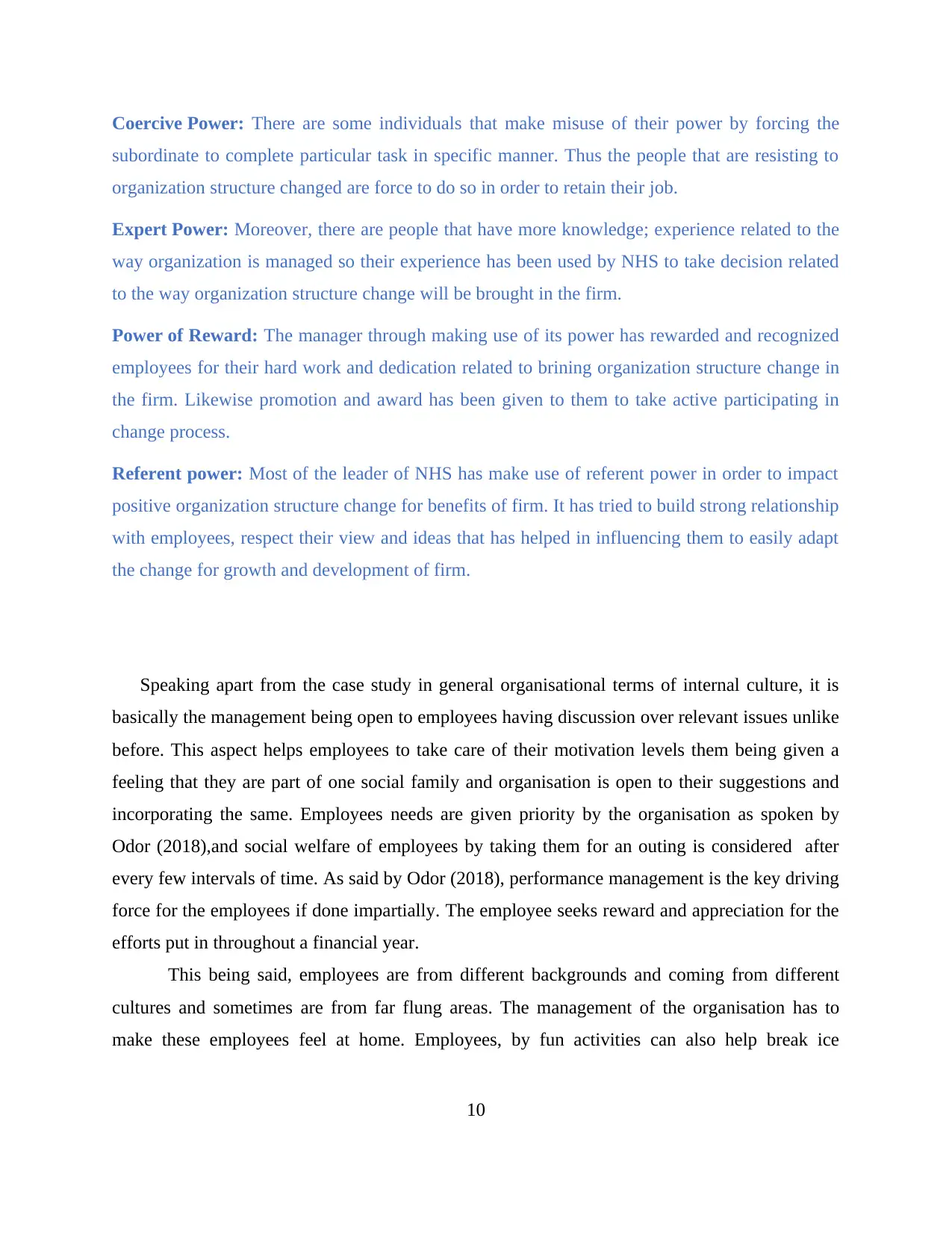
Coercive Power: There are some individuals that make misuse of their power by forcing the
subordinate to complete particular task in specific manner. Thus the people that are resisting to
organization structure changed are force to do so in order to retain their job.
Expert Power: Moreover, there are people that have more knowledge; experience related to the
way organization is managed so their experience has been used by NHS to take decision related
to the way organization structure change will be brought in the firm.
Power of Reward: The manager through making use of its power has rewarded and recognized
employees for their hard work and dedication related to brining organization structure change in
the firm. Likewise promotion and award has been given to them to take active participating in
change process.
Referent power: Most of the leader of NHS has make use of referent power in order to impact
positive organization structure change for benefits of firm. It has tried to build strong relationship
with employees, respect their view and ideas that has helped in influencing them to easily adapt
the change for growth and development of firm.
Speaking apart from the case study in general organisational terms of internal culture, it is
basically the management being open to employees having discussion over relevant issues unlike
before. This aspect helps employees to take care of their motivation levels them being given a
feeling that they are part of one social family and organisation is open to their suggestions and
incorporating the same. Employees needs are given priority by the organisation as spoken by
Odor (2018),and social welfare of employees by taking them for an outing is considered after
every few intervals of time. As said by Odor (2018), performance management is the key driving
force for the employees if done impartially. The employee seeks reward and appreciation for the
efforts put in throughout a financial year.
This being said, employees are from different backgrounds and coming from different
cultures and sometimes are from far flung areas. The management of the organisation has to
make these employees feel at home. Employees, by fun activities can also help break ice
10
subordinate to complete particular task in specific manner. Thus the people that are resisting to
organization structure changed are force to do so in order to retain their job.
Expert Power: Moreover, there are people that have more knowledge; experience related to the
way organization is managed so their experience has been used by NHS to take decision related
to the way organization structure change will be brought in the firm.
Power of Reward: The manager through making use of its power has rewarded and recognized
employees for their hard work and dedication related to brining organization structure change in
the firm. Likewise promotion and award has been given to them to take active participating in
change process.
Referent power: Most of the leader of NHS has make use of referent power in order to impact
positive organization structure change for benefits of firm. It has tried to build strong relationship
with employees, respect their view and ideas that has helped in influencing them to easily adapt
the change for growth and development of firm.
Speaking apart from the case study in general organisational terms of internal culture, it is
basically the management being open to employees having discussion over relevant issues unlike
before. This aspect helps employees to take care of their motivation levels them being given a
feeling that they are part of one social family and organisation is open to their suggestions and
incorporating the same. Employees needs are given priority by the organisation as spoken by
Odor (2018),and social welfare of employees by taking them for an outing is considered after
every few intervals of time. As said by Odor (2018), performance management is the key driving
force for the employees if done impartially. The employee seeks reward and appreciation for the
efforts put in throughout a financial year.
This being said, employees are from different backgrounds and coming from different
cultures and sometimes are from far flung areas. The management of the organisation has to
make these employees feel at home. Employees, by fun activities can also help break ice
10
Paraphrase This Document
Need a fresh take? Get an instant paraphrase of this document with our AI Paraphraser
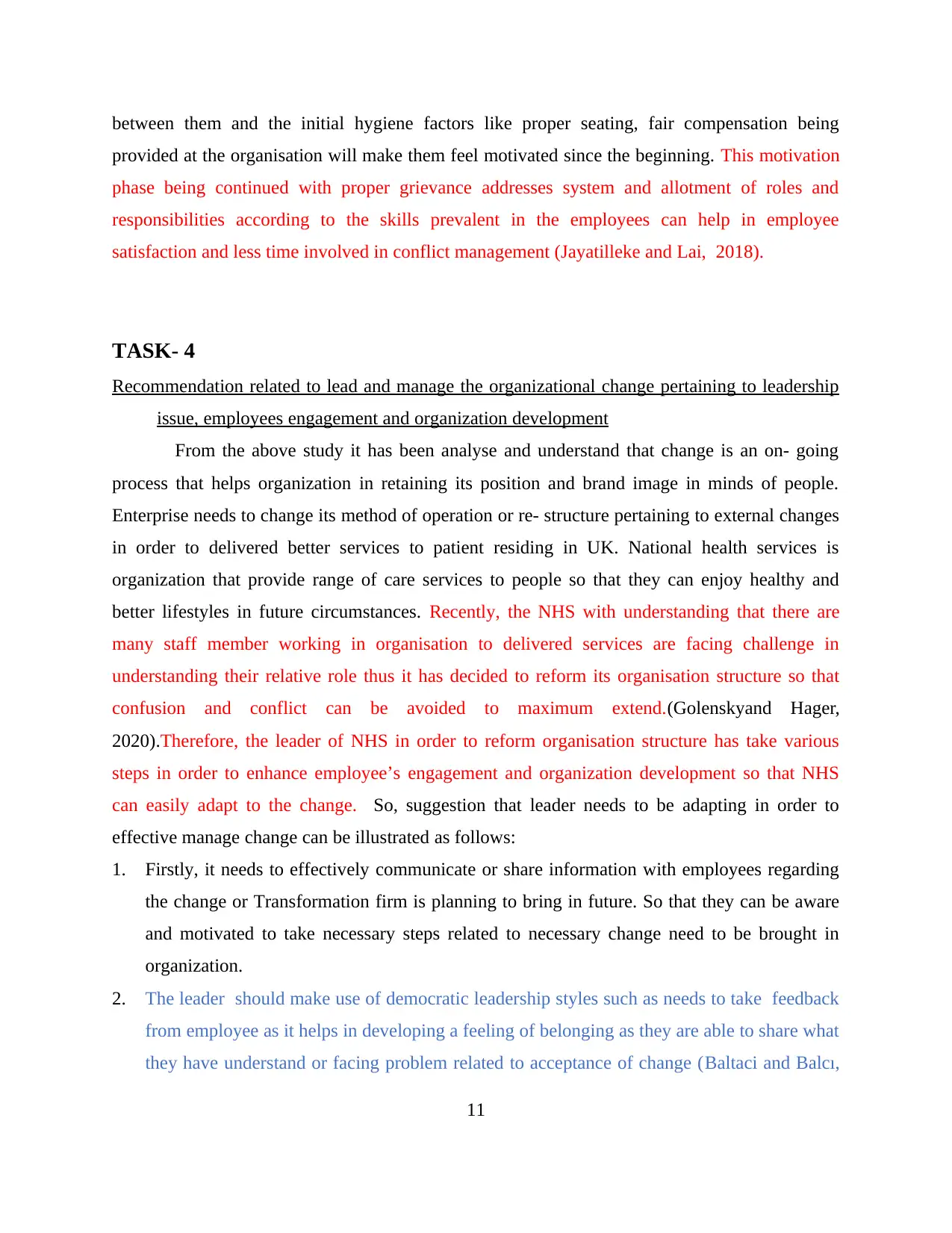
between them and the initial hygiene factors like proper seating, fair compensation being
provided at the organisation will make them feel motivated since the beginning. This motivation
phase being continued with proper grievance addresses system and allotment of roles and
responsibilities according to the skills prevalent in the employees can help in employee
satisfaction and less time involved in conflict management (Jayatilleke and Lai, 2018).
TASK- 4
Recommendation related to lead and manage the organizational change pertaining to leadership
issue, employees engagement and organization development
From the above study it has been analyse and understand that change is an on- going
process that helps organization in retaining its position and brand image in minds of people.
Enterprise needs to change its method of operation or re- structure pertaining to external changes
in order to delivered better services to patient residing in UK. National health services is
organization that provide range of care services to people so that they can enjoy healthy and
better lifestyles in future circumstances. Recently, the NHS with understanding that there are
many staff member working in organisation to delivered services are facing challenge in
understanding their relative role thus it has decided to reform its organisation structure so that
confusion and conflict can be avoided to maximum extend.(Golenskyand Hager,
2020).Therefore, the leader of NHS in order to reform organisation structure has take various
steps in order to enhance employee’s engagement and organization development so that NHS
can easily adapt to the change. So, suggestion that leader needs to be adapting in order to
effective manage change can be illustrated as follows:
1. Firstly, it needs to effectively communicate or share information with employees regarding
the change or Transformation firm is planning to bring in future. So that they can be aware
and motivated to take necessary steps related to necessary change need to be brought in
organization.
2. The leader should make use of democratic leadership styles such as needs to take feedback
from employee as it helps in developing a feeling of belonging as they are able to share what
they have understand or facing problem related to acceptance of change (Baltaci and Balcı,
11
provided at the organisation will make them feel motivated since the beginning. This motivation
phase being continued with proper grievance addresses system and allotment of roles and
responsibilities according to the skills prevalent in the employees can help in employee
satisfaction and less time involved in conflict management (Jayatilleke and Lai, 2018).
TASK- 4
Recommendation related to lead and manage the organizational change pertaining to leadership
issue, employees engagement and organization development
From the above study it has been analyse and understand that change is an on- going
process that helps organization in retaining its position and brand image in minds of people.
Enterprise needs to change its method of operation or re- structure pertaining to external changes
in order to delivered better services to patient residing in UK. National health services is
organization that provide range of care services to people so that they can enjoy healthy and
better lifestyles in future circumstances. Recently, the NHS with understanding that there are
many staff member working in organisation to delivered services are facing challenge in
understanding their relative role thus it has decided to reform its organisation structure so that
confusion and conflict can be avoided to maximum extend.(Golenskyand Hager,
2020).Therefore, the leader of NHS in order to reform organisation structure has take various
steps in order to enhance employee’s engagement and organization development so that NHS
can easily adapt to the change. So, suggestion that leader needs to be adapting in order to
effective manage change can be illustrated as follows:
1. Firstly, it needs to effectively communicate or share information with employees regarding
the change or Transformation firm is planning to bring in future. So that they can be aware
and motivated to take necessary steps related to necessary change need to be brought in
organization.
2. The leader should make use of democratic leadership styles such as needs to take feedback
from employee as it helps in developing a feeling of belonging as they are able to share what
they have understand or facing problem related to acceptance of change (Baltaci and Balcı,
11
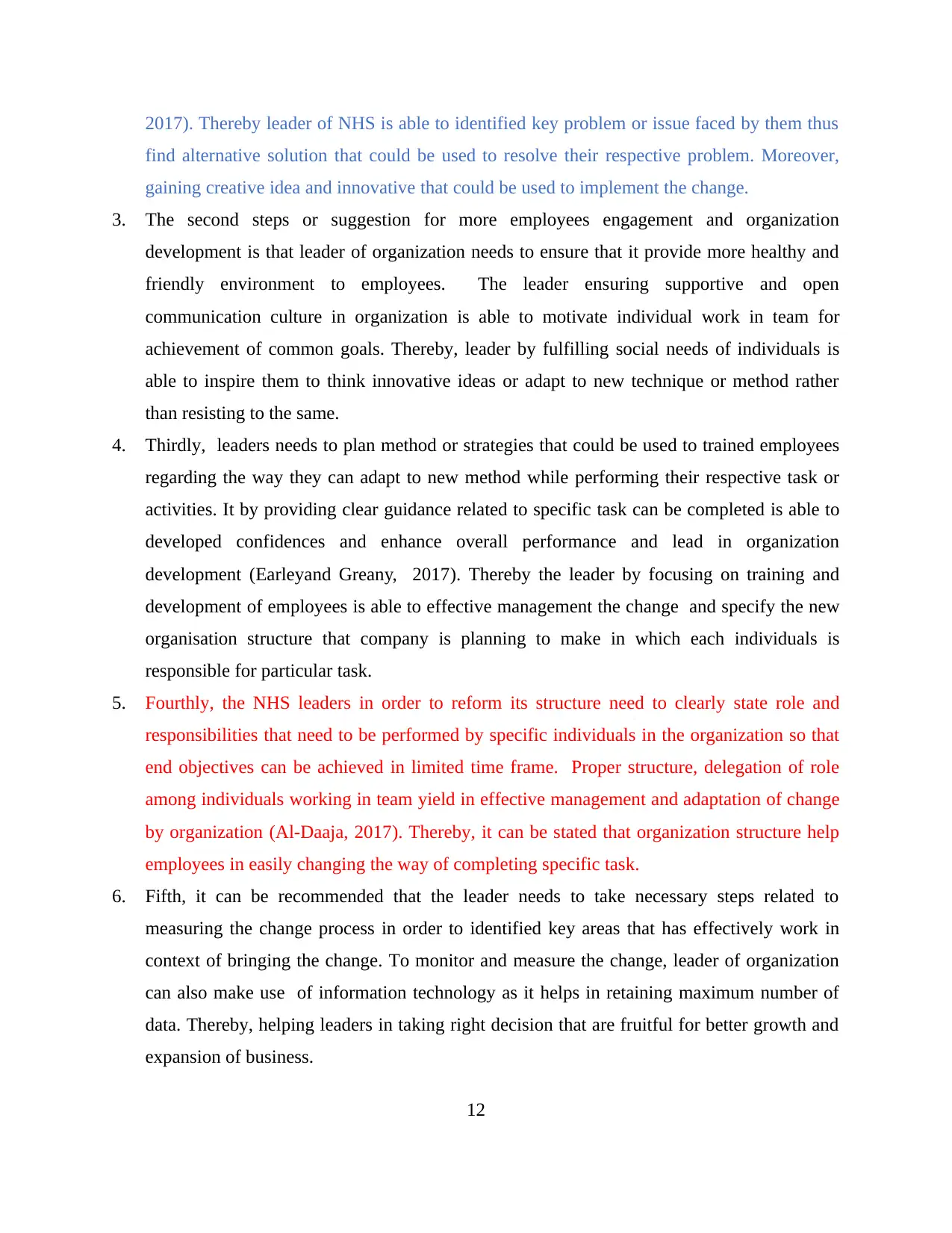
2017). Thereby leader of NHS is able to identified key problem or issue faced by them thus
find alternative solution that could be used to resolve their respective problem. Moreover,
gaining creative idea and innovative that could be used to implement the change.
3. The second steps or suggestion for more employees engagement and organization
development is that leader of organization needs to ensure that it provide more healthy and
friendly environment to employees. The leader ensuring supportive and open
communication culture in organization is able to motivate individual work in team for
achievement of common goals. Thereby, leader by fulfilling social needs of individuals is
able to inspire them to think innovative ideas or adapt to new technique or method rather
than resisting to the same.
4. Thirdly, leaders needs to plan method or strategies that could be used to trained employees
regarding the way they can adapt to new method while performing their respective task or
activities. It by providing clear guidance related to specific task can be completed is able to
developed confidences and enhance overall performance and lead in organization
development (Earleyand Greany, 2017). Thereby the leader by focusing on training and
development of employees is able to effective management the change and specify the new
organisation structure that company is planning to make in which each individuals is
responsible for particular task.
5. Fourthly, the NHS leaders in order to reform its structure need to clearly state role and
responsibilities that need to be performed by specific individuals in the organization so that
end objectives can be achieved in limited time frame. Proper structure, delegation of role
among individuals working in team yield in effective management and adaptation of change
by organization (Al-Daaja, 2017). Thereby, it can be stated that organization structure help
employees in easily changing the way of completing specific task.
6. Fifth, it can be recommended that the leader needs to take necessary steps related to
measuring the change process in order to identified key areas that has effectively work in
context of bringing the change. To monitor and measure the change, leader of organization
can also make use of information technology as it helps in retaining maximum number of
data. Thereby, helping leaders in taking right decision that are fruitful for better growth and
expansion of business.
12
find alternative solution that could be used to resolve their respective problem. Moreover,
gaining creative idea and innovative that could be used to implement the change.
3. The second steps or suggestion for more employees engagement and organization
development is that leader of organization needs to ensure that it provide more healthy and
friendly environment to employees. The leader ensuring supportive and open
communication culture in organization is able to motivate individual work in team for
achievement of common goals. Thereby, leader by fulfilling social needs of individuals is
able to inspire them to think innovative ideas or adapt to new technique or method rather
than resisting to the same.
4. Thirdly, leaders needs to plan method or strategies that could be used to trained employees
regarding the way they can adapt to new method while performing their respective task or
activities. It by providing clear guidance related to specific task can be completed is able to
developed confidences and enhance overall performance and lead in organization
development (Earleyand Greany, 2017). Thereby the leader by focusing on training and
development of employees is able to effective management the change and specify the new
organisation structure that company is planning to make in which each individuals is
responsible for particular task.
5. Fourthly, the NHS leaders in order to reform its structure need to clearly state role and
responsibilities that need to be performed by specific individuals in the organization so that
end objectives can be achieved in limited time frame. Proper structure, delegation of role
among individuals working in team yield in effective management and adaptation of change
by organization (Al-Daaja, 2017). Thereby, it can be stated that organization structure help
employees in easily changing the way of completing specific task.
6. Fifth, it can be recommended that the leader needs to take necessary steps related to
measuring the change process in order to identified key areas that has effectively work in
context of bringing the change. To monitor and measure the change, leader of organization
can also make use of information technology as it helps in retaining maximum number of
data. Thereby, helping leaders in taking right decision that are fruitful for better growth and
expansion of business.
12
⊘ This is a preview!⊘
Do you want full access?
Subscribe today to unlock all pages.

Trusted by 1+ million students worldwide
1 out of 16
Related Documents
Your All-in-One AI-Powered Toolkit for Academic Success.
+13062052269
info@desklib.com
Available 24*7 on WhatsApp / Email
![[object Object]](/_next/static/media/star-bottom.7253800d.svg)
Unlock your academic potential
Copyright © 2020–2025 A2Z Services. All Rights Reserved. Developed and managed by ZUCOL.





